
System Integration: Uniting Technology for Seamless Business Operation
In this digital age, businesses are increasingly reliant on interconnected systems, and the art of systems integration is the key to unlocking their true potential.
Whether it’s bridging the gap between enterprise applications, integrating legacy systems, or enabling faster electronic document flow within the company, system integration is the driving force behind streamlined operations and increased productivity for organizations of all types.
Join us as we explore the types, benefits, implementations, and common approaches to systems integration and uncover the secrets to achieving a synchronized and connected IT ecosystem.
What is system integration?
System integration is the process of combining different subsystems or components into a unified and cohesive system. In the realm of information technology, it involves merging various software applications, databases, hardware devices, and networks to ensure seamless communication and data flow.
Why integrate?
In today’s increasingly connected world, organizations often rely on multiple systems and technologies to perform different functions. However, these disparate systems can operate in isolation, leading to inefficiencies, data inconsistencies, and limited collaboration between departments.
System integration addresses these challenges by enabling disparate system components to work together harmoniously, enabling better decision-making, increased productivity, and improved customer experiences.
Organizations typically require system integration in several scenarios.
For example, when a company acquires a new business or merges with another company, integrating existing systems becomes critical to streamlining operations and achieving synergies.
Similarly, when implementing a new enterprise resource planning (ERP) system, integration with existing systems is critical for seamless data exchange across functional areas.
And as organizations increasingly adopt cloud-based applications and services, integrating these cloud software solutions with on-premises systems becomes necessary to effectively leverage the benefits of both environments. In addition, in the age of digital transformation, system integration plays a pivotal role in connecting disparate systems, enabling real-time data analysis, supporting agile decision-making, and fostering innovation.
Five key benefits of system integration
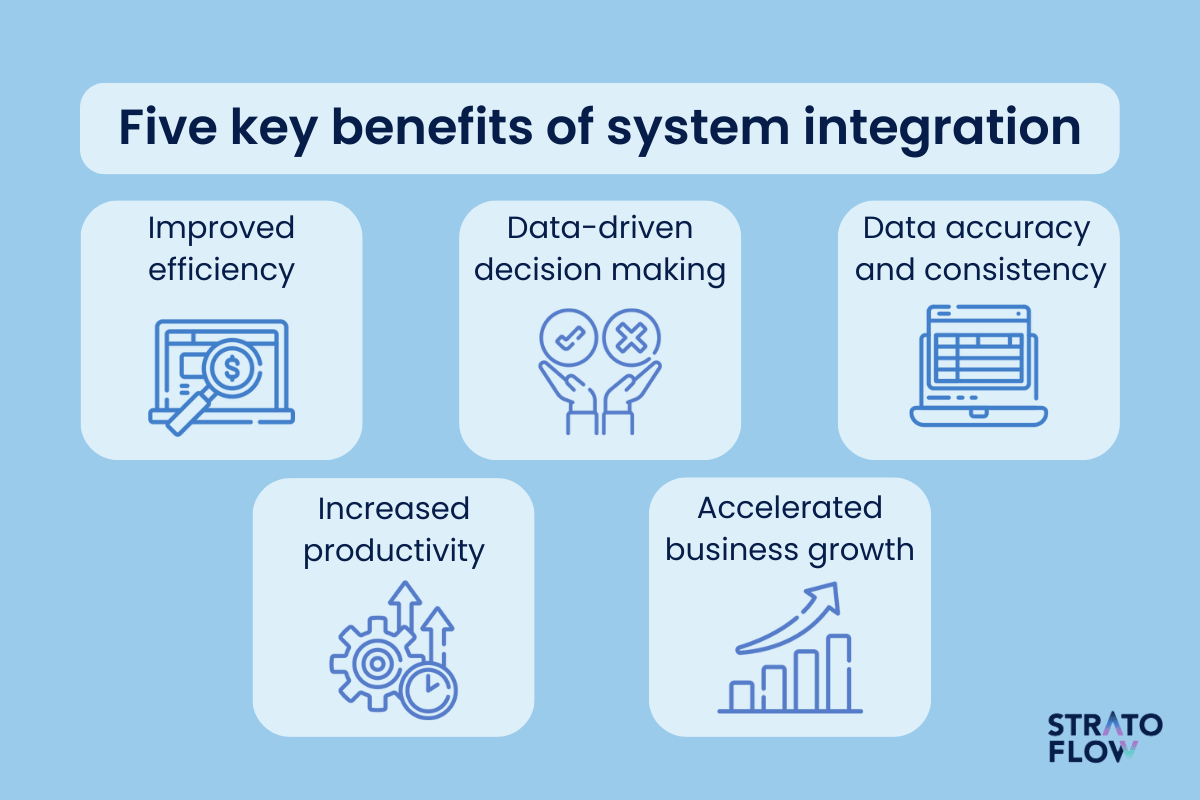
Improved efficiency
Improved efficiency is at the heart of any system integration effort.
By seamlessly connecting disparate systems and applications, organizations can eliminate inefficient data silos and streamline operations. This eliminates redundant tasks, reduces manual data entry, and enables efficient collaboration across departments.
The result?
Accelerated workflows, streamlined processes, and a significant increase in overall productivity.
Better data-driven decision making
System integration also plays a key role in enabling better data-driven decision making.
By integrating data from multiple sources and applications, organizations can gain a comprehensive view of their operations. Real-time, accurate, and unified data empowers decision-makers to make informed decisions, identify trends, and respond quickly to changing market conditions.
With actionable insights at their fingertips, businesses can navigate the competitive landscape with confidence and precision.
Improved data accuracy and consistency
By integrating systems, organizations can eliminate data discrepancies and inconsistencies that often result from maintaining multiple databases or applications. With data synchronized and standardized across the enterprise, companies can rely on accurate information for strategic planning, forecasting, and customer interactions.
The result is improved customer satisfaction, increased operational efficiency, streamlined business processes, and minimized risks associated with inaccurate data.
Increased productivity
With a unified system interface, employees can seamlessly access relevant data and functionality, eliminating the need to switch between applications.
This saves time, reduces frustration and operational costs, and allows employees to focus on their core tasks. By leveraging integrated systems, organizations can foster a culture of productivity and empower their workforce to achieve more.
Accelerated business growth
Finally, system integration enables accelerated business growth.
By harnessing the power of integrated systems, businesses can scale and expand more efficiently. With integrated data and streamlined processes, companies can quickly adapt to market changes, embrace new technologies, and take advantage of new business opportunities.
With improved agility and optimized operations, businesses can position themselves for sustainable growth and competitive advantage.
Four main types of system integration
Since we already know what and why let’s focus on how and begin with covering four main types of system integrations approaches.
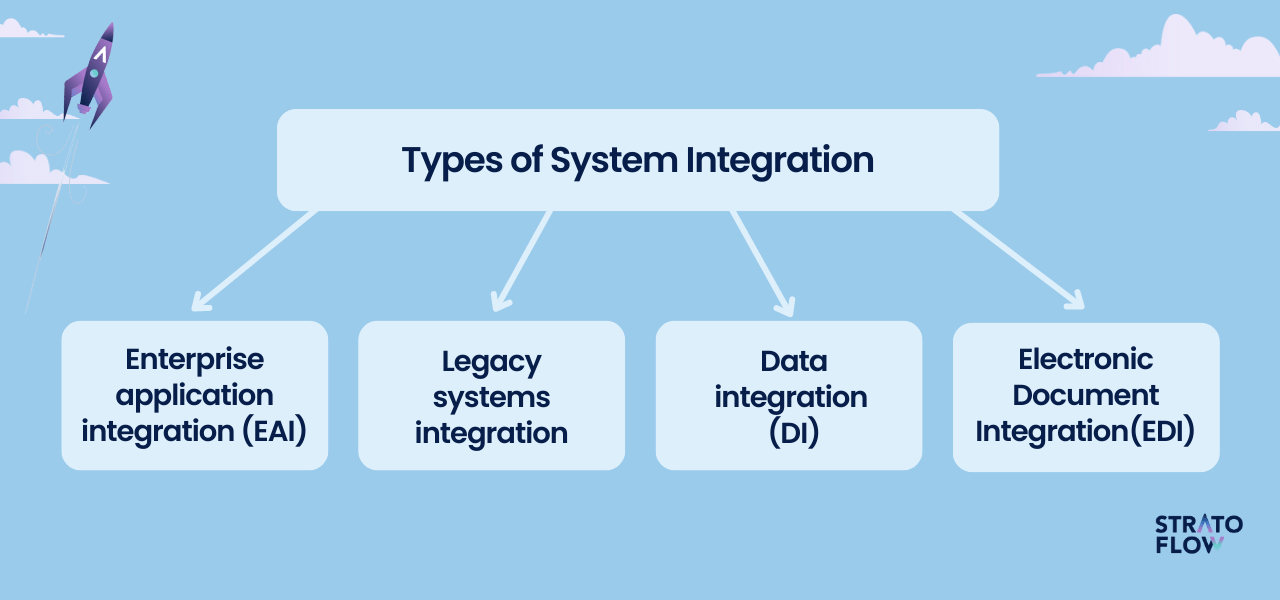
Enterprise application integration (EAI)
In today’s complex business landscape, companies rely on multiple applications to manage different functions such as customer relationship management (CRM), supply chain management (SCM), and financial systems.
However, these applications often operate in isolation, resulting in inefficiencies and limited collaboration.
Enter Enterprise Application Integration (EAI), a powerful solution that bridges the gap between disparate applications, enabling seamless communication, data sharing, and business process orchestration.
The Goal
The primary purpose of EAI is to integrate disparate applications and systems within an organization to achieve a unified view and flow of data.
By establishing connections between applications, EAI ensures that information can be seamlessly exchanged, shared, and synchronized across departments.
With enterprise application integration, organizations can streamline processes, improve operational efficiency, and enhance collaboration between teams.
Real-world example
Company X, a multinational retailer, implements EAI to connect its CRM, ERP, and inventory management systems.
By integrating these applications, Company X achieves a single view of customer data, streamlines order processing, and improves inventory management. The integration enables seamless communication between departments, improving overall operational efficiency and customer satisfaction.
Legacy systems integration
Legacy systems, which refer to older, often proprietary software or hardware, can hinder operational efficiency and impede progress toward digital transformation.
However, just like an old car that needs some maintenance, older legacy software systems can be integrated with more modern solutions to bridge the gap between the past and the future, unlocking the potential of existing structures while embracing new technologies.
The Goal
The main purpose of legacy system integration is to seamlessly connect and integrate legacy systems with modern applications and infrastructure.
As a result, organizations can leverage the valuable data and functionality contained in their legacy systems while taking advantage of the scalability, agility, and advanced capabilities of modern technologies.
Legacy Systems Integration enables organizations to extend the life of their existing software architecture, reduce the risk of potential disruptions, and minimize the need for costly system replacements. It allows organizations to modernize their operations without sacrificing the investment and knowledge embedded in legacy systems.
Real-world example
Company Y, a financial institution, is integrating its legacy mainframe system with modern banking technology.
By implementing legacy systems integration, Company Y can leverage its existing core banking system while providing customers with an easy-to-use and feature-rich online banking experience.
This integration bridges the gap between legacy systems and modern technology, allowing the organization to improve customer service, streamline processes, and support digital transformation.
Data integration (DI)
Today’s organizations are faced with an abundance of data spread across multiple sources and formats.
Data Integration (DI) provides a solution that enables organizations to consolidate, transform, and harmonize their data to create a unified view for improved decision-making and operational excellence.
The Goal
The primary purpose of data integration is to bring together disparate data from multiple sources and systems, including databases, applications, and data warehouses, to create a consistent, common data format.
By integrating data, organizations can eliminate data silos and create a unified data ecosystem.
This integrated approach provides a holistic and comprehensive view of data, enabling organizations to gain meaningful insights, discover trends, and make informed decisions. In addition, data integration enables real-time or near real-time synchronization of data, ensuring that information is current and reliable for timely decision-making.
Real-world example
Company Z, a global e-commerce retailer, implements data integration to consolidate customer data from multiple sources, including its e-commerce platform, CRM system, and social media channels. By integrating this data, Company Z gains a comprehensive view of customer interactions, preferences, and purchase history. This enables the company to personalize marketing campaigns, improve customer segmentation, and deliver a seamless omnichannel experience.
Electronic document integration/interchange (EDI)
When it comes to running a business, there’s one thing that’s an inseparable part of it, regardless of the type of business or industry – the sheer volume of documents involved.
From invoices and purchase orders to employee records, the constant flow of various forms of documentation is becoming increasingly difficult to keep track of.
That’s where Electronic Document Integration/Interchange (EDI) comes in as a powerful solution that enables companies to seamlessly exchange standardized electronic documents, replacing manual and paper-based processes.
The Goal
The primary purpose of EDI is to facilitate the electronic exchange of business documents, such as purchase orders, invoices, and shipping notices, between trading partners.
By standardizing the format and structure of these documents, EDI eliminates manual data entry, reduces errors, and speeds up transaction processing. This streamlined approach to document exchange improves efficiency, increases accuracy, and reduces costs associated with paper-based processes.
Implementing EDI has significant implications for businesses. First, it promotes efficient and reliable communication with trading partners. EDI also plays a critical role in supply chain management. By automating the exchange of critical documents such as purchase orders and shipping notices, companies can streamline procurement processes, accelerate order fulfillment, and improve inventory management.
Real-world example
Company A, a manufacturing enterprise, uses EDI to exchange electronic documents with its suppliers and customers.
By implementing EDI, Company A eliminates paper-based processes and manual data entry, reducing processing time and errors. The integration enables automated ordering, electronic invoicing, and real-time status updates, improving supply chain visibility and collaboration with trading partners.
Common system integration methods
Having covered the importance and types of system integration projects let’s now take a closer look at different methods of conducting integration ventures as each works best in very specific business scenarios:

System integration approach #1: Point-to-point integration
In the realm of system integration, the point-to-point approach is considered to be the simplest and most efficient system integration method for directly connecting two systems and establishing a direct communication link between them.
The point-to-point integration approach follows a fairly simple pattern:
- First, the integration team identifies the two systems to be connected.
- They analyze the data requirements and communication protocols of each system to ensure proper compatibility.
- Then, the team develops and deploys a bespoke integration solution that enables the direct flow of data between the two systems.
This typically involves the development of APIs, custom connectors, or adapters that enable seamless data transfer.
A point-to-point integration approach allows organizations to quickly establish connections between systems, streamlining data exchange and enabling near real-time information flow. It also minimizes reliance on a central integration platform, reducing complexity and infrastructure costs.
It is important to note, however, that as the number of integrations grows, managing multiple point-to-point integrations can become increasingly challenging.
Each new integration requires separate development efforts, increasing maintenance overhead and potentially creating a spaghetti-like network of integrations.
Organizations should carefully consider the scalability and long-term manageability of the point-to-point approach for larger integration initiatives before choosing the simplest ad-hoc solution.
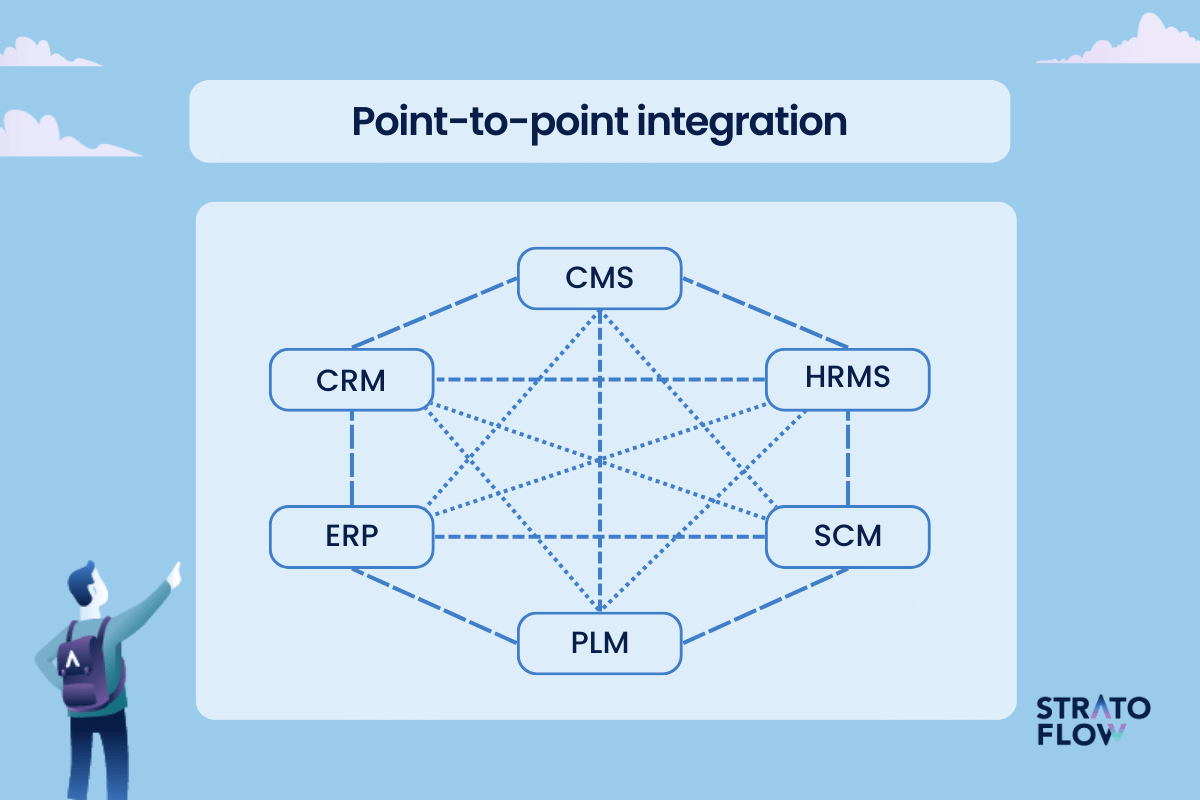
[Read also: Top Software Development Methodologies: How to Choose the Right One?]
System integration approach #2: Vertical integration
The vertical integration approach takes a more comprehensive and holistic perspective, aiming to connect and integrate systems across different layers of an organization’s technology stack.
The vertical integration approach is often used when organizations seek to consolidate and streamline their operations by integrating systems and applications across different functional areas, such as sales, finance, inventory management, and production.
The integration process using the vertical integration approach involves connecting systems and applications vertically along the organizational hierarchy.
Similar to the point-to-point approach, it begins by assessing the organization’s technology landscape and identifying key systems that need to be integrated.
Integration efforts then focus on establishing connections and data exchange protocols between systems in different functional areas to ensure data consistency and process harmonization. This often requires the implementation of an enterprise service bus (ESB), electronic data interchange (EDI), or integration middleware that serves as a central hub for data transformation, routing, and orchestration.
Vertical integration enables organizations to achieve end-to-end visibility and control of their operations, which facilitates better decision-making, process optimization, and resource allocation.
It also supports scalability by enabling the seamless addition of new systems and capabilities, allowing organizations to adapt to changing business needs and technological advances.
This all sounds great, but there’s a catch.
Implementing the vertical integration approach is notoriously complex and resource-intensive. It requires careful planning, extensive interdepartmental coordination, and stakeholder involvement. The integration process can involve significant changes to existing systems, requiring data mapping, transformation, and migration.
Before embarking on vertical integration, consider contacting a custom software development company with experience in developing custom integration solutions.

System integration approach #3: Star integration
Star integration, also known as the hub-and-spoke model approach, revolves around a central hub that acts as the focal point for data exchange and integration.
The key feature of this approach is its centralized architecture, where multiple systems are connected to a central hub, allowing for seamless communication and data flow between them.
The star integration approach is often used when organizations want to consolidate data from multiple systems and enable efficient collaboration between different departments or business units.
By connecting systems to a central hub, organizations can simplify future integration efforts by allowing the hub to perform data transformation and routing tasks.
The integration process using the star integration approach involves connecting different systems and applications to the central hub, typically through integration middleware or an enterprise service bus (ESB). The central hub facilitates data transformation, routing, and orchestration to enable seamless data exchange between connected systems.
This approach ensures data consistency, reduces complexity, and simplifies the integration process.
However, organizations should also consider the potential challenges associated with the star integration approach. The central hub becomes a critical component, and any failure or bottleneck in the hub can affect the entire integrated system.
Therefore, robust monitoring, redundancy, and scalability measures must be implemented to ensure high availability and peak software performance.
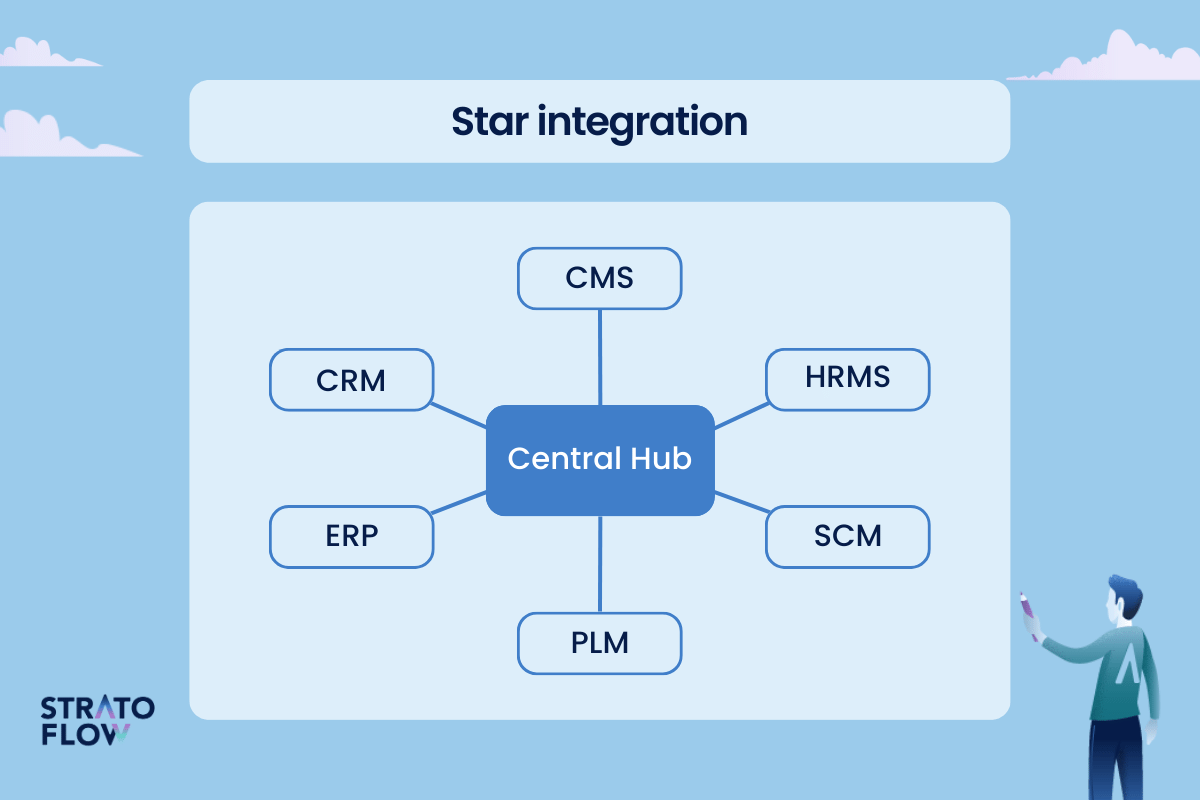
System integration approach #4: Horizontal integration
In the realm of system integration, the horizontal integration approach focuses on connecting systems and applications that perform similar functions or operate within the same business process area.
The horizontal integration approach is often used when organizations want to streamline processes, improve cross-functional collaboration, and achieve a consistent and standardized approach to specific business functions.
This integration typically occurs at the application or data layer, enabling the seamless exchange of data and information between systems. The goal is to unify processes, eliminate data silos, and enable smooth collaboration between different teams or departments.
However, ensuring compatibility and data consistency across integrated systems can be complex, requiring careful data mapping, transformation, and synchronization.
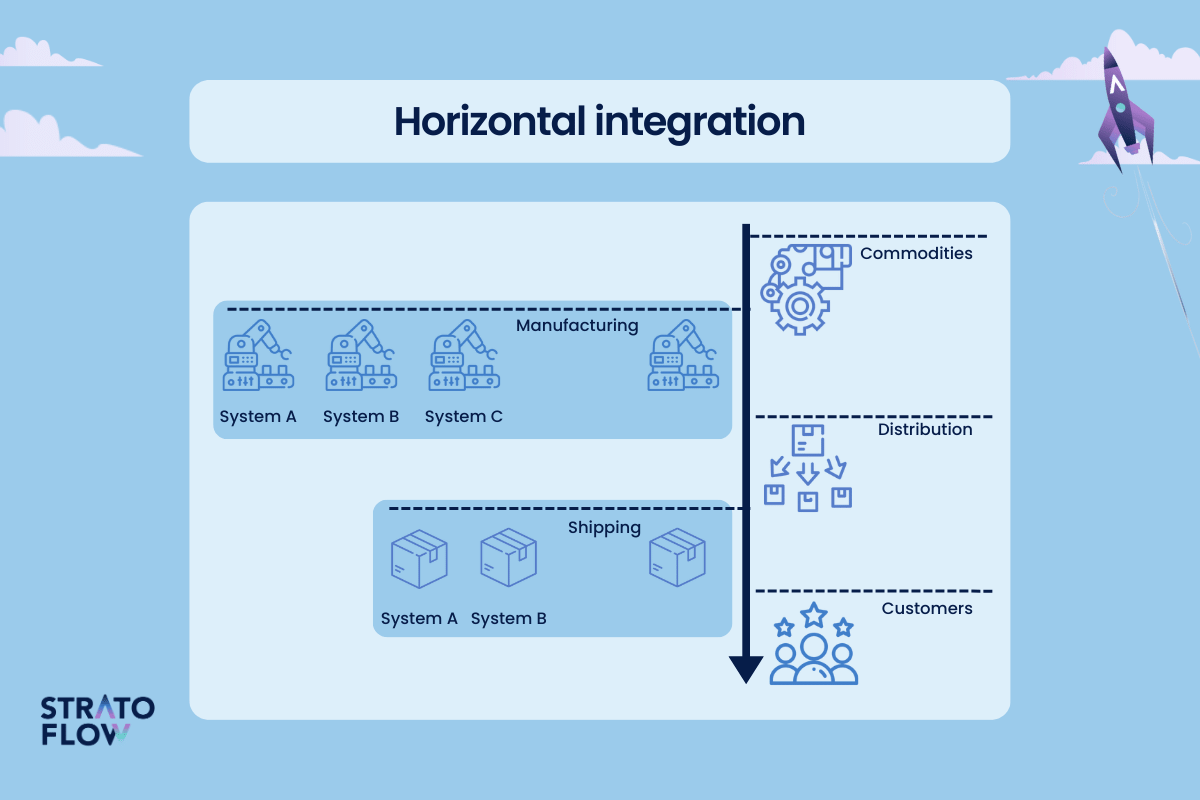
Five steps of system integration
system integration projects are typically complex endeavors that require specialized knowledge and years of experience to yield positive results. However, every system integration project has five distinct phases that are absolutely critical to creating a complete working software solution. Let’s take a closer look at them:
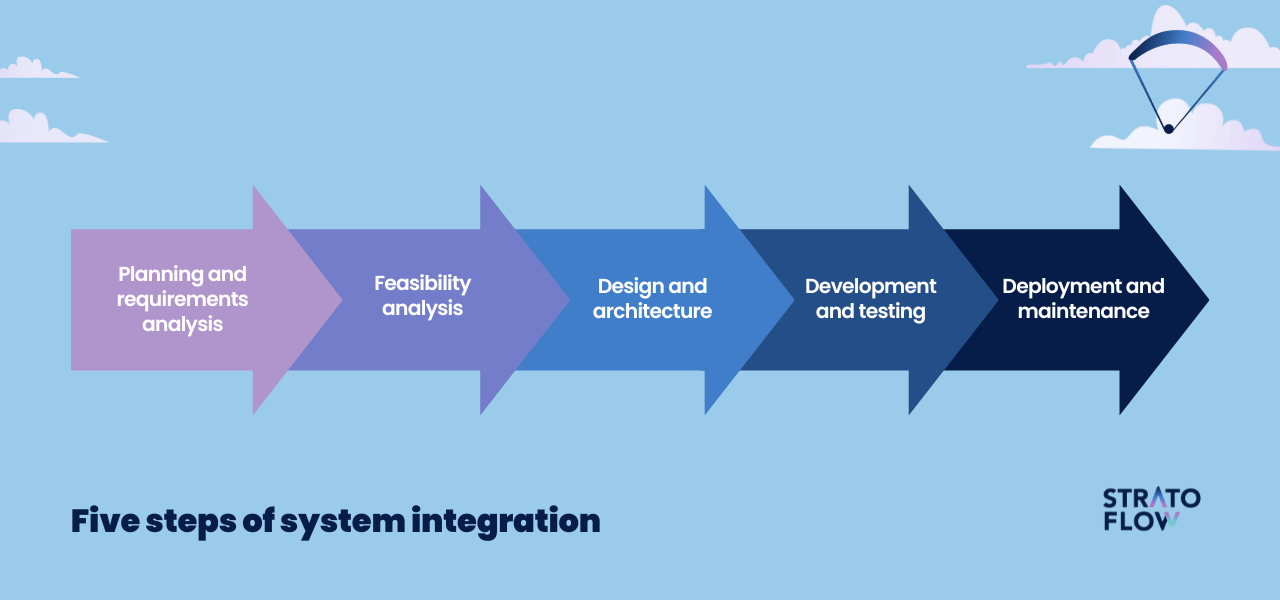
Planning and requirements analysis
The first step in system integration should always be thorough planning and analysis.
This includes identifying integration objectives, understanding business requirements, and assessing the existing system landscape.
This step lays the foundation for a successful integration by defining the scope, goals, and expected outcomes of the project. Through careful requirements analysis, organizations can identify key functionality, data exchange needs, and performance expectations for the integrated systems.
From there, they can choose an appropriate integration approach and, if necessary, seek the help of a custom software development company.
Feasibility analysis
In addition to planning and analysis, company executives should also ask themselves a very important question – is the project we have in mind even feasible?
This may sound silly at first, but in reality, it is a valid and critical question to answer.
A feasibility analysis should be conducted to evaluate the viability and potential challenges associated with the systems integration project.
It involves assessing the technical feasibility and considering factors such as system compatibility, data formats, and communication protocols. Once the project is determined to be feasible, the deeper analysis examines the financial and operational feasibility by considering the costs, resources, and potential risks associated with the integration process.
This step helps organizations make informed decisions and plan a realistic and achievable integration strategy.
Design and architecture
Once the planning and feasibility phases are complete, the next step is to design the integration solution and define the system architecture.
This involves identifying the integration patterns, data flows, and communication protocols that best fit the initial assumptions and plans.
Designing a robust and scalable architecture ensures that the integrated systems can exchange data effectively, communicate seamlessly, and accommodate future growth and change.
The design phase also considers factors such as data mapping, transformation, security, and error handling to ensure data integrity and system reliability. Clearly, the importance of this phase cannot be overstated, as it has a direct impact on the ability to expand and scale in the future.
Development and testing
After the design phase, it is time to work on the final integration solution.
Developers work on system integration by building the necessary interfaces, connectors, and adapters that enable the smooth flow of data between systems.
Thorough software testing should be performed to verify the functionality, reliability, and performance of the integration solution. This includes unit testing, integration testing, performance testing, and end-to-end testing to ensure that the integrated systems work together and meet the desired business requirements.
All of this helps to identify potential bottlenecks before final deployment.
Deployment and maintenance
The final step in system integration is to deploy the integrated solution in the production environment and ensure its ongoing maintenance.
This includes deploying the necessary hardware, software, and infrastructure components and configuring the systems for optimal performance. After deployment, organizations must establish monitoring mechanisms, implement security measures, and perform periodic maintenance to ensure the continued smooth operation of the integrated systems.
Ongoing support and maintenance are critical to resolve issues, implement updates, and address future integration requirements.
[Read also: Documenting Software in Development Projects: Types, Best Practices, and Tools]
Common problems when conducting system integration and how to avoid them
The system integration process can be complex and challenging and often presents several hurdles that software developers must overcome to ensure successful integration.
Below, we’ve listed five of the most common obstacles a system integrator may face and the most important things to keep in mind when connecting disparate software systems.
- Compatibility and system dependencies – A common problem in system integration is when the integrated systems are not fully compatible or have dependencies that are not properly addressed. When working on systems integration projects, developers must consider factors such as system versions, APIs, data formats, and communication protocols.
- Data integrity and transformation – Data inconsistencies and inaccuracies can hinder the smooth operation of integrated systems. Developers should focus on data integrity throughout the integration process, paying careful attention to data mapping, transformation, and validation. It is essential to ensure that data is accurately translated and matched between systems while maintaining its integrity and quality.
- Data lineage – Data lineage refers to the complete journey of data, from its origin to its transformation and movement across various systems and processes. In complex integration projects, maintaining accurate and up-to-date data lineage becomes increasingly difficult as discrepancies or gaps in data lineage can lead to integrity issues, hinder troubleshooting efforts, and impact decision-making based on incomplete or inaccurate information.
- Data traceability – A noteworthy subtype of data lineage is called business lineage or data traceability. Normal, technical lineage shows how data flows, moves, and transforms between different software systems. Business lineage or data traceability focuses on the role of certain information within the organization. A proper data governance solution should thus carefully curate reliable and credible technical resources while enabling various business units to incorporate and connect business terms, processes, policies, and other data concepts modeled by the organization.
- Error Handling and Fault Tolerance – System integration projects can experience unexpected errors or failures that can disrupt the overall process. Developers should implement effective error handling and fault tolerance mechanisms to handle exceptions, recover from failures, and maintain system stability. This includes implementing comprehensive logging, exception handling, and recovery strategies to minimize the impact of errors and maintain the integrity of integrated systems.
- Performance and Scalability – Poor software performance and scalability can pose a significant challenge to systems integration, especially by today’s standards. Developers should carefully evaluate the performance and scalability requirements of the integrated systems to ensure that the solution can handle increasing data volumes and significant user loads. By optimizing code, implementing caching mechanisms, and conducting proper software performance testing, developers can identify and address potential bottlenecks early on to ensure a seamless and efficient integration experience.
- Security and Access Control – Security is a critical aspect of systems integration because it involves the exchange of sensitive data between interconnected systems. Developers should prioritize security measures such as data encryption, authentication, and access control to protect the integrity and confidentiality of the integrated systems.
Final words
In the ever-evolving landscape of technology and IT infrastructure, systems integration plays a critical role in driving efficiency, collaboration and growth within organizations. By harnessing the power of software integration and following a thoughtful and systematic process, organizations can unlock the potential of their interconnected systems, paving the way for streamlined processes, data-driven decision-making, and increased productivity.
Related Posts
- Best AI for Coding: Top 10 AI Tools for Software Developers in 2025
- 23 Best Books for Software Engineers in 2023
- How to Build an Inventory Management System: Key Steps and Tips
- How to Build a Document Management System: Alternative Approach
- Online Shopping Recommendations – Introducing Them to Your Business
Thank you for taking the time to read our blog post!